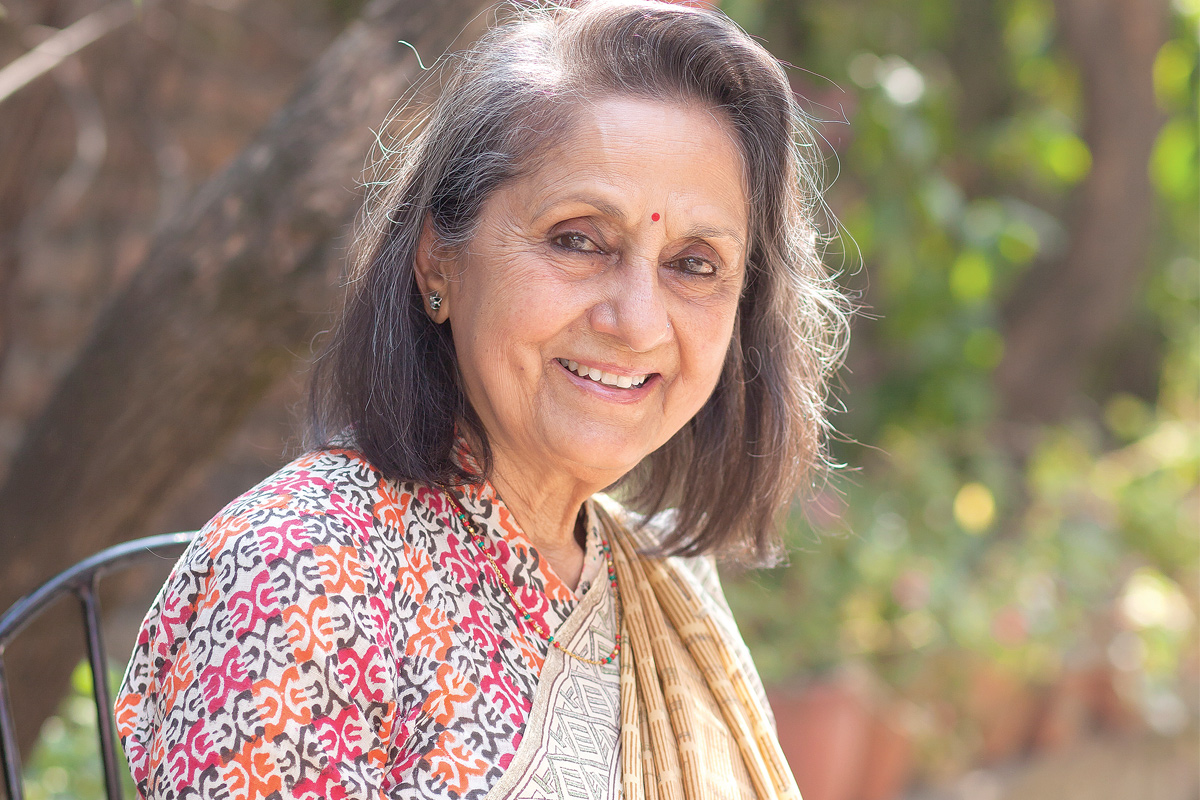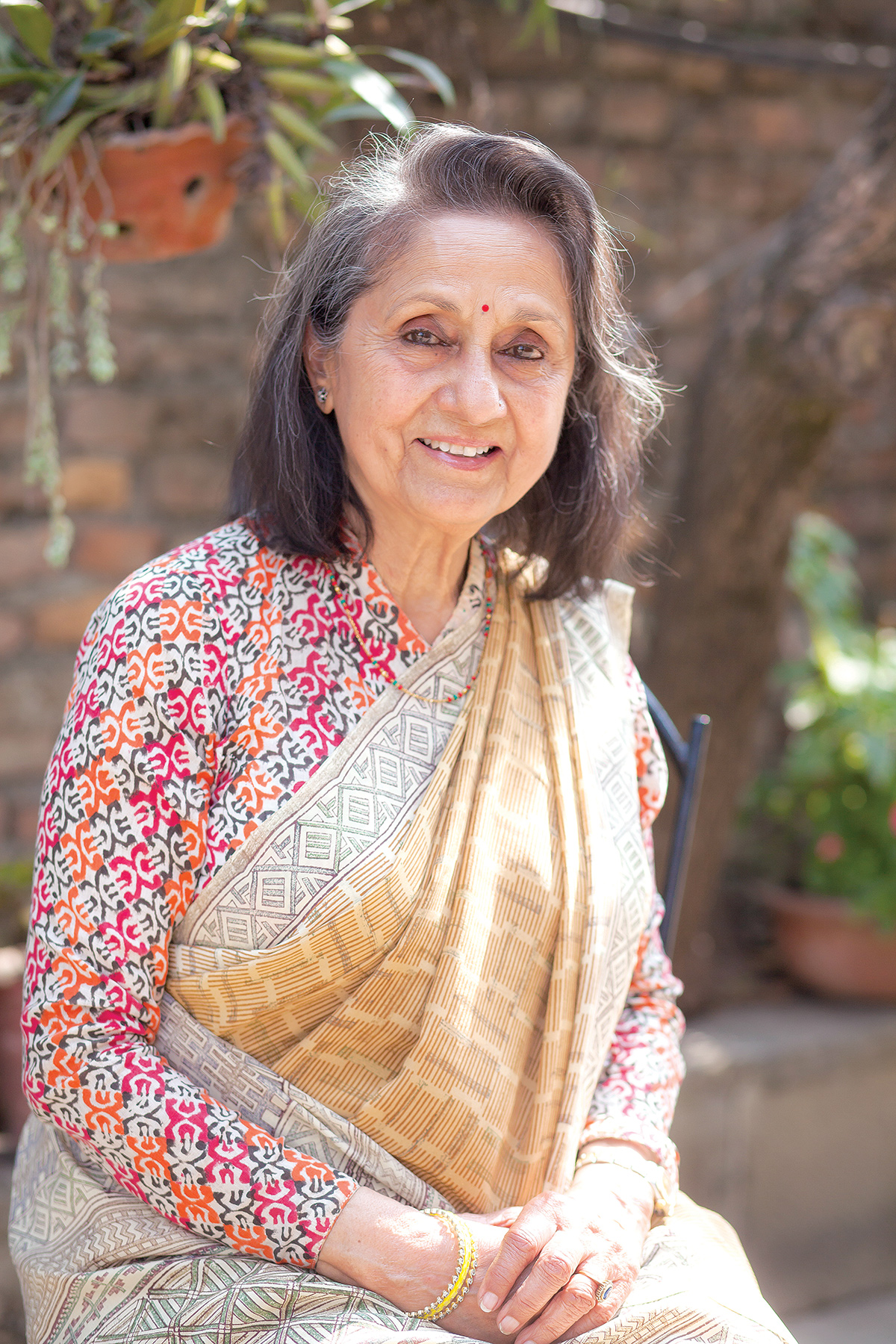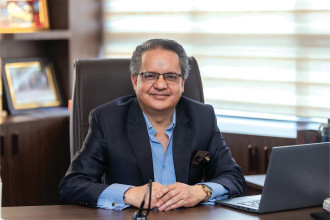
Dr. Rita Thapa is the Founding Chairperson of Bhaskar-Tejshree Memorial Foundation. Dr. Thapa has recently pioneered an original research on changing school adolescent’s mortality associated Cardiovascular - NCD risk behaviours in Nepal, which was recently published in Global Heart Journal. She is also the Pro Bono Executive Director of Tejshree Initiative for Empowerment of School Adolescents for Prevention of Sexual Harassment (TIPSH).
Dr. Thapa’s career spans 56 years and she is widely regarded as the person who pioneered the training and mobilisation of community-based health workers to reach out to rural mothers and children at the time of virtual absence of health workers especially in rural areas of the country. She earned her MPH from Johns Hopkins in 1965 and is known as the visionary and founder of Nepal’s primary health care system which has been responsible for making Nepal a global leader in reducing maternal and child mortality.
She is one of the few people still living who attended the famous 1978 International Conference on Primary Health Care at Alma-Ata, Kazakhstan, representing Nepal and signing the Declaration of Alma-Ata, which is now considered the “gold standard” for primary health care programs around the world. After serving in Nepal’s Ministry of Health for nearly 20 years, she joined WHO in Manila, Geneva and New Delhi as the first woman Department Director in the WHO South East Asia Regional Office (SEARO) since its establishment in 1948.
Upon her retirement from the WHO, Dr. Thapa has served Nepal in several capacities: as a member of High Level Health Policy Restructuring Committee, Ministry of Health; a Visiting Professor, School of Public Health School of Public Health and Community Medicine, B. P. Koirala Institute of Health Sciences, Dharan; President of Nepal Perinatal Society of Nepal; a senate member, Kathmandu University. She also served as the President of Nepal Public Health Foundation.
Dr. Rita Thapa has been recognised for her dedication and her contributions in public health with several national and international awards. Most recently, Dr. Thapa was awarded the Distinguished Alumni award by the John Hopkins University in 2019 for outstanding contribution in the field of public health. In 2018 she received the Life Time Achievement Award by the Perinatal Society of Nepal for her outstanding contribution and service to Perinatal Health in Nepal and in 2016, she was awarded the Life Time Achievement Award by the Nepal Public Health Foundation among many others through the years.
In an interview with B360’s Avant Shrestha, Dr. Thapa shares her views on leadership, the importance of teamwork, her career as a public health worker and her journey and achievements in the line of public health. Excerpts.

What is your definition of leadership?
When I started my career, I did not know what leadership was all about. It is when I started my work in a maternity hospital I actually started experientially learning leadership. In my opinion as I look at my career, leadership to me basically meant realising a common vision or a goal or a good cause through a team approach. But that should be laced with lots of empathy, understanding, integrity, commitment and of course communication. And at the end, when leadership succeeds, every team member should feel that the success belongs to them, they did it; the team should feel that they are responsible as well. That’s how I have experienced leadership and what it means to me. Of course, there are many other academic definitions.You have a lifetime of experience in public health and are widely regarded as the visionary and founder of Nepal’s Primary Health Care System which has been responsible for making Nepal a global leader in reducing maternal and child mortality in spite of the political turmoil that Nepal experienced for the past three decades. How did you keep yourself motivated in your work?
First of all, I am inspired by many people. When I was growing up I was inspired by wonderful people like Mahatma Gandhi and Shakyamuni Buddha. When I came to work, the first lessons I learned was in the maternity hospital where I was appointed first. During my time there, I saw lots of women who came year after year with repeated pregnancies, in very deplorable conditions, often with life-threatening complications. I was a young woman who had just come out from medical college and I did not know much about many things. So, I asked a very honest question to one of the pregnant women, ‘why do you always want to get pregnant?’ And after a while she politely retorted saying that “Dr. Sab we are not like you; we have to do whatever our husband wants”. And that was an eye-opening moment for me because suddenly I saw these women’s powerless in their own reproductive choice. And that was a huge challenge for me. It was the moment when I silently committed to help women empower themselves in their own reproductive rights. This is what led me to become the first Chief of the government’s family planning and maternal child health program. Despite a gentle warning by the then Director General of Health Services, Dr. Dinesh Ananda Vaidya that ‘public health has neither money nor glamour’, I have never looked back. I enjoyed working in this broad field which took me to communities all over within and outside Nepal. And I believe that my main motivation and strength is community-based actions.
What are the challenges you have faced in leadership roles?
I had my own gender battles to fight while I was Chief of Maternal Health and Family Planning. There was a male foreign advisor as my colleague from an important donor agency. But this male representative of a major donor agency wished to separate FP from MCH as was the practice in neighboring countries, while I was insistent on keeping Family Planning and Maternal and Child Health services as a single integrated package delivered from one door. His idea of separation did not sit well with our field evidence which showed integrated MCH-FP services to be more synergistic and holistic, especially at a time when under-five mortalities was sky touching high. To my shock, I learnt that not only did this male representative of a donor agency provoke the predominantly male staff in my office not to work under a woman; he also went on to lobby for my transfer from the project. However, thanks to the political leadership of that time, the government stood firmly by the side of the integrated approach. I continued as the chief of the project and he left after completing his assignment. I was not surprised to hear, a few years later, that he was expelled from work for his anti-woman behaviour. I did not face gender bias from my Nepali colleagues but this one person has left a mark on me and I will never forget that. It was quite challenging. Of course, there are many other challenges I faced along the way.Do you then believe that it is correct to say that an individual’s gender can obstruct them from fulfilling their duties, especially in leadership role?
I could describe this in one word: our ‘patriarchal’ mindset. This is the biggest challenge that we have in our country. Whether we are aware or not, unconsciously our patriarchal behaviour puts a barrier on women leadership from birth onwards. This, I consider a major hurdle for women to be in leadership roles. For example, I am not demeaning men when I say this; in fact, men in leadership positions, except a few, around the world are doing great. But if you look at the recent news during the corona virus pandemic, all the 10 countries that were headed by women leaders were doing much better than those led by men. In our country, the main blockage is patriarchal social norms and mindset, which I believe is the most difficult barrier for Nepali women’s leadership. And this is the main root of many other problems as well like sexual violence against women.What are the greatest strengths and weaknesses of a leader?
I believe one of the greatest strengths has to be a risk-taking mentality. For example, I have taken big risks. Even when I was working at WHO, after one point I was going to resign. There are many instances of such risk taking. My motivation for taking that kind of risk comes from my conviction that what I am doing or trying to do is evidence based, is for the common good. In the field of public health, my conviction comes from bringing better health to people. The strength comes from belief in what one is doing. I believe the biggest weakness is if you don’t trust your team, if you lie and are not honest towards your work. And lastly, if you do not delegate appropriate tasks and decision-making and trust your team, you cannot achieve the end public health results. In fact, I did not do anything except delegating my authority in regard to public health, it was the people, the team members all the way down to the villages, they did it best.How important are team members for a leader?
Team members are very important, epacially in public health. I have to go back to the very base period when we didn’t have any health infrastructure, we didn’t have any hospitals expect in Kathmandu, Biratnagar and Birjung. We basically had no human resources. And in terms of maternal and child health and family planning, reaching every pregnant mother and children with basic services meant requiring a large number of technical staff, doctors and trained nurses which the country did not have. We started virtually at a zero level with only three full time staff, a public health nurse Miss Tamsang, WHO advisor Dr. Ida Von Dijk and myself. But, we started building our team, starting with a quick functional analysis study in the FP-MCH clinics in Kathmandu. Our findings showed that many of the tasks undertaken by doctors did not actually require their presence. In view of this, we conceived the idea of creating an entirely new category of basic health worker consisting of local females to deliver specific services as trained for. But it was not as easy to convert our evidence-based idea into a government policy. The Finance Ministry official I met instantly rejected it calling it an unsustainable idea, arguing that Nepal was “too poor to pay the salaries of hundreds of new health workers, even though external donors might temporarily fund it”. But somehow, we convinced him that he was the most brilliant economist in the country, and he will soon make Nepal prosperous so that even a rural citizen can have aspirin in need. This was an important landmark moment when we broke away from the old health paradigm which had failed to respond to existing FP-MCH needs. The old health paradigm required every health technology to be delivered either by a doctor or by trained nurse who were scarce commodities then. Just imagine, if we had waited through all these years, how many lives we would have lost.Could you share the moment you knew that community-based health service would actually work?
An interesting incident happened while I was in Ilam in 1968 to establish new.family planning and maternal child health care clinics (FP-MCH). Around midnight, a health assistant came with a crying mother with a severely dehydrated baby. Initially, I panicked. I had nothing at hand to deal with that sort of situation. But as a doctor I had to do something. I improvised an oral vesion of normal saline drip. I instructed the mother to make “medicine water” by boiling about five tea glasses of water (1 liter) with a pinch of salt and a fistful of sugar (6 teaspoons sugar), and to let it cool, then feed it to the child intermittently even while breastfeeding her. Having done what I could, I prayed and went back to sleep, but with a lingering fear that the child would not make it. At around five in the morning, when I opened the door, I saw a miracle: the child was playing on her mother’s lap. It was a blessing. It erased my initial doubt of whether our innovation of using community-based health workers would be accepted by community. Diarrhea used to be the number one killer of children then. The people in villages did just the opposite by not give any water and fluid to people suffering from diarrhea. But the mother in this incident changed that behaviour. Another aspect of this incident was that mothers themselves could make such lifesaving “medicine water” using their own kitchen ingredients. And we could develop such skills among mothers across the country. That is how the modern, commercially produced oral rehydration solution called ‘Jeewan Jal” was born in Nepal. This incident reminded me of what our Professor late Carl Taylor in John Hopkins used to say, ‘mothers are the best health care providers, use homes and communities as the best places for health care facility, and regard behaviour change as the number one medicine for true health.’ After this, there was no stopping us. It showed me how to scale FP-MCH nationwide. Today’s healthier Nepal shows this concept has really worked well.When you look back as the first Chief of the Integrated Community Health Services Development Project (ICHSDP), Nepal’s primary health care system, what kind of efforts were needed to lead and establish a countrywide network of Integrated District Health System consisting of district health offices, health posts, village health workers, mothers’ groups, and female community health volunteers?
When the then Director-General of Health Services, Dr. Narendra Dhoj Joshi appointed me as the Chief of the Integrated Community Health Services Development Project, I was quite hesitant. This was a mega-project, born out of an imminent threat of resurgence of malaria in the country. Nepal’s malaria eradication project had reached its targeted maintenance level by 1972, but there was no basic health service infrastructure yet to maintain this gain. This is when the government changed its policy from a “vertical approach” to an “integrated approach”, creating the Integrated Community Health Services Development Project. It was a huge challenge for me to negotiate with the chiefs of the five vertical projects-malaria, family planning and maternal health, smallpox eradication, tuberculosis and leprosy control projects, to unify their functions, staffs, and operations under the single administrative umbrella of the Integrated Community Health Services Development Project. We began with a team of 19 people whom I considered as our gems. As they were mostly drawn from the vertical projects, their expertise was most valuable to ensure the interests of respective vertical projects. We gradually managed to work with the vertical project chiefs. This, among other works, also entailed endless discussions and arguments with my five brothers as I called them - the five “vertical” projects chiefs, who were united in their opposition to an integrated approach. We worked on a war footing to establish a countrywide network of integrated District Health Offices, integrated health posts and linking them with VHWs, Mothers’ Groups, and Female Community Health Volunteers (FCHVs) within the districts. We institutionalised the basic primary health care services provided by the five “vertical” projects by organising them along an integrated district-level health system, while safeguarding their service quality down to community level. Finally, all the vertical projects agreed to unify them under a single name: Village Health Workers (VHWs). For example, small pox vaccinators, FP-MCH health aids, and malaria home visitors were all unified as Village Health Workers (VHWs) working under the respective integrated health posts supervised by the district health offices. While the job entailed much hard talk and hard work, it gave me an opportunity to innovate yet another category of health workers- the female community health volunteers (FCHVs), one from each ward. We took help of Mothers’ Groups to recruit FCHVs. We trained FCHVs in a staggered way starting with basics like hand washing, breast milk, family planning, infant and child feeding, treating and preventing protein-calorie malnutrition with homemade and affordable foods such as a traditional gruel called “Lito” which has since gone into commercial production as “Sarbottam Pitho”. Looking back, I feel extremely rewarded when I see studies reporting that the female community health volunteers have effectively contributed to maternal mortality reduction as the country’s alternative pathways and strategies. It was not an easy job, but I had immensely enjoyed my work in establishing a country wide integrated district health systems with more than 50,000-ward level Female Community Health Volunteers delivering a proven set of interventions that helped Nepal achieving the Millennium Development Goals in child and maternal mortality. The district health systems made it easier for the FCHVs to visit respective health post every month for re-orientation, including reporting about health situation in their respective wards.You have contributed immensely in establishing health and family planning for the neediest and in the neglected areas in the country. However maternal and peri-natal health problems still remain prevalent primarily due to the lack of adequate facilities and manpower in rural areas of the country. What can be done?
You know, that universal health basically means ideal state of social, mental and physical situation, not just absence of illness. That is our aspiration and we should work towards it. But talking about maternal health in Nepal, I would like to request all of us to look back to the time when the government started FP-MCH project in 1960s. The mileage we have made since then is dramatic. When I started my job, women had no control on their own reproductive choice, now 43% of them use modern contraceptives with total fertility rate falling from six children per woman to 2-3 children per woman. Unattended home delivery was universal with maternal death taken to be a normal fate of being women, now 57 % women have institutional delivery. The maternal mortality ratio has now declined to less than 239 from its natural level of 1,500 and above per 100,000 live births in the 1960s, and children aged 12-23 months having all basic vaccinations that rose to 78% from zero. These are no small gains for a country held back by centuries of feudalism, poverty, ill health, a decade long internal conflict. However, coming back to the question, I agree even the 239 maternal mortality is too high. No woman should die of complications of pregnancy and childbirth. Better maternal and perinatal health demands better quality of maternal, perinatal and neonatal health care which unfortunately is missing here, especially in rural areas.Leadership to me basically meant realising a common vision or a goal or a good cause through a team approach. But that should be laced with lots of empathy, understanding, integrity, commitment and of course communication.At the same time, we were surprised to find that, despite the decade long internal conflict, maternal, child mortality, and total fertility continued to decline between 1996 and 2006. After a technical discussion at a conference, we concluded that it was not because of improved quality of maternal health care, it was more because of family planning use. As soon as the risk of being pregnant goes down, the risk of maternal and child mortality also goes down. Use of contraceptives was quite popular during the conflict including among combatants. I believe that maternal health needs more investment, because it means improving health of the entire family which pays back six times more than investment.
During your time at the Ministry of Health as a Senior Health Policy Advisor what kind of responsibility was placed upon you?
Upon my retirement from the WHO, I was appointed as the Senior Policy Advisor. In this capacity I contributed to health sector reform and health sector wide strategy. And later on, I contributed as a member of High Level Health Policy Restructuring Committee, Ministry of Health.Would you like to tell us about Bhaskar-Tejshree Memorial Foundation?
The organisation was purely founded to honour two of our children. Bhaskar was a brilliant child and unfortunately we lost him to a sudden heart attack, at a very young age. That really shook me. All my professional life, I was focused on saving children under the age of five and their mothers. This unbearable tragic incident suddenly diverted my attention to prevention of heart diseases which is the largest killer in Nepal and in the world. Our research, conducted among school adolescents across the seven provinces, has shown statistically significant reduction of the five deadly risk behaviours of heart and other non-communicable diseases (NCD), with only 25 credit hours of experiential learning. This original research has been published in peer reviewed global heart journal. I feel highly encouraged that many more Bhaskars could be saved from premature deaths if these proven learning methods are included in the existing NCD school curriculum. I believe, schools can be a gateway for prevention of heart and non-communicable disease in Nepal. I am now working on this. We are now actively working on a project to honour the human rights legacy of our beloved daughter advocate late Tejshree Thapa. We didn’t realise all the good things that she had done before she passed away. She never talked about herself. We learned about them only from her public obituaries published in the New York Times and others. They described her as a trailblazing layer exposing war crimes with her lead contributions to establishing rape as a crime against humanity while working with the International Criminal Tribunal for the former Yugoslavia. This project, Tejshree Initiative for Empowerment of School Adolescents for Prevention of Sexual Harassment, aims to empower school adolescents with knowledge, attitude and skills to overcome the twin problems of gender discrimination and sexual harassment. So far, we have completed a small pilot project involving school students - boys and girls in Tanahun, by joining hands with another NGO called ‘Fightback’. The preliminary findings are very optimistic and it gives us the confidence to go ahead.What would you consider your most significant accomplishment?
All of them are equally important for me. I believe my work and family complement each other. It is not like one or the other. I am glad that I was able to manage time for all of them. I am very grateful to my husband, Dr. Bhekh Bahadur Thapa, who is very considerate and understanding. Sometimes in our life, we had to live apart because of my work with the WHO. When Dr. Bhekh was appointed as Nepal’s ambassador to the US, I enjoyed working as a full time ambassador’s wife. But then I started missing my work, which made me sad. Despite some murmur from the palace, I took the offer from WHO for a short assignment in primary health care, but without ignoring the family needs. I felt happy to be able to help my husband in making the State visit of Their Majesties King Birendra and Queen Aishwarya to the US a great success. I also realised during my Washington DC days how difficult it is to be a full-time spouse, a house wife. I have developed a lot of respect for the women who are full time house wives and manage so well. But, I also realise that it is possible to combine a fulltime career along with a happy family life. I believe, all this can be done. But there should be harmony, understanding, love and mutual trust within the family.
Published Date: February 22, 2021, 12:00 am
Post Comment
E-Magazine
RELATED Leadership



-(1)-1752214965.jpg)
-1744698999.jpg)